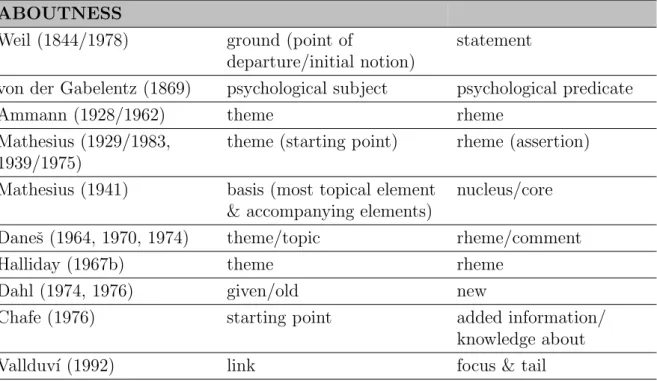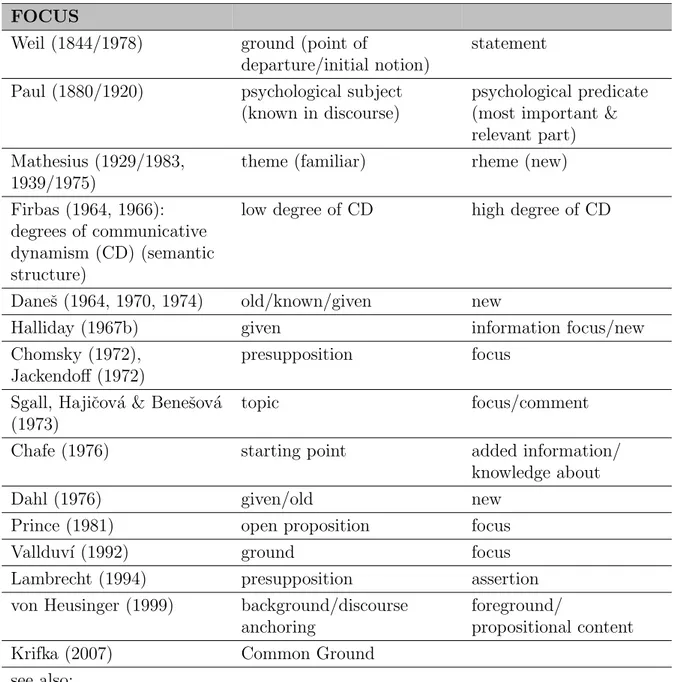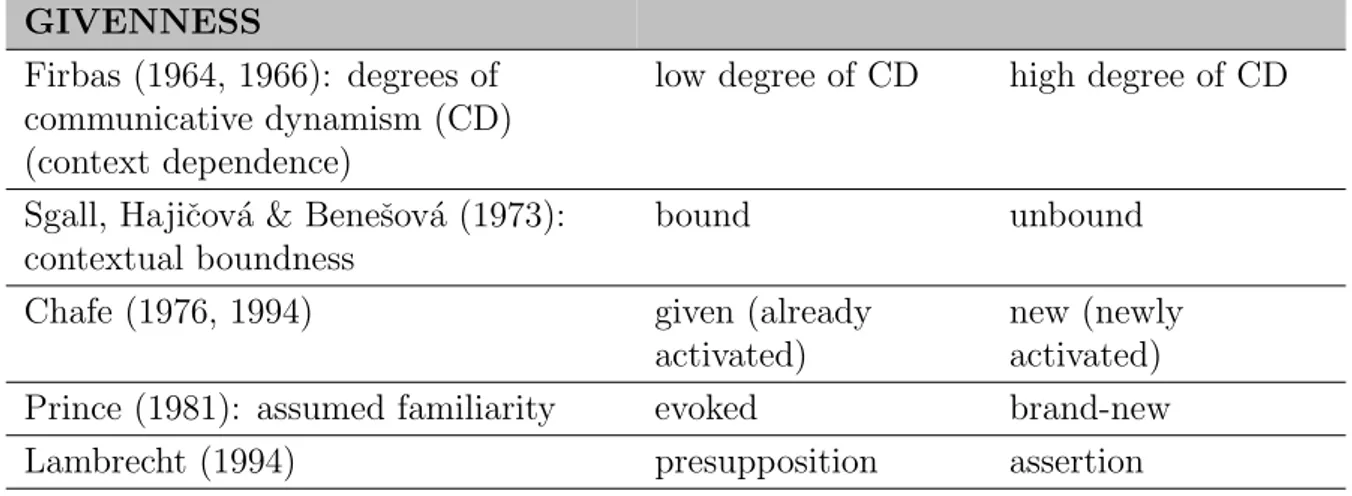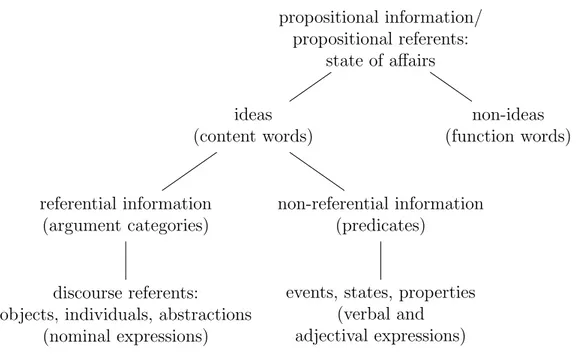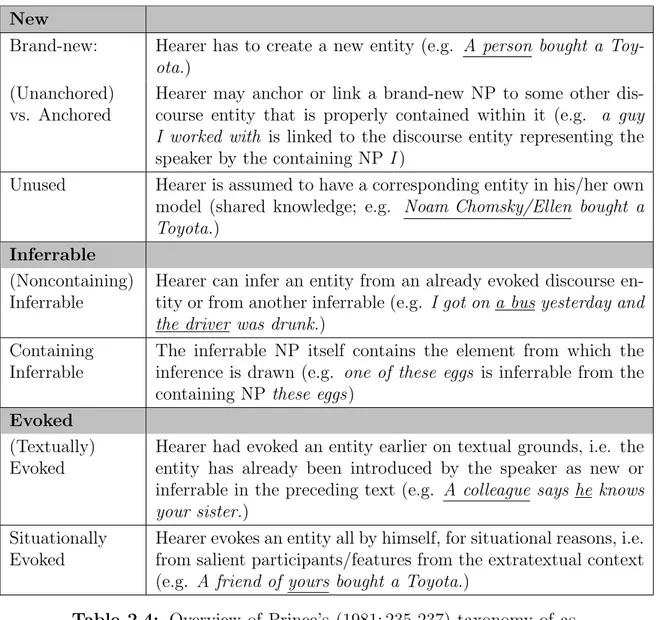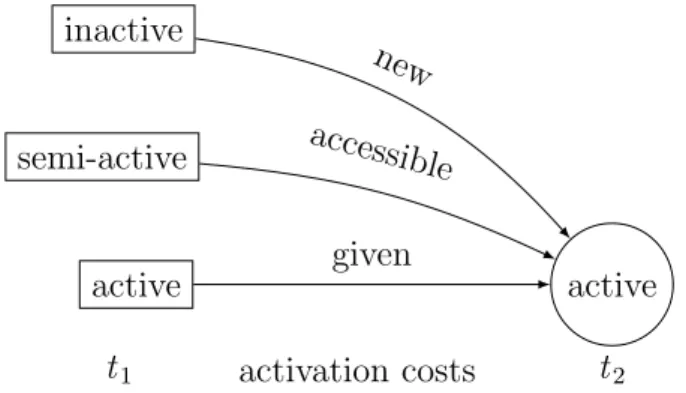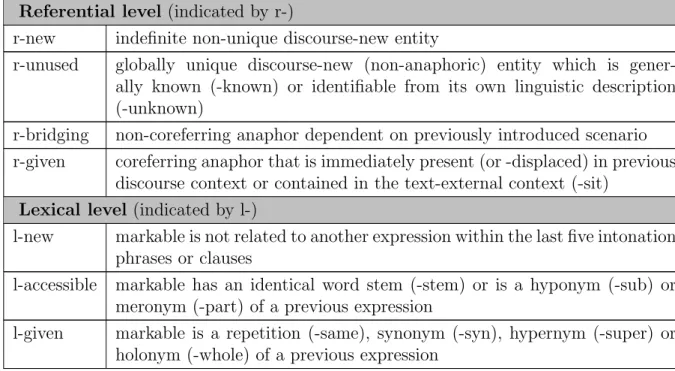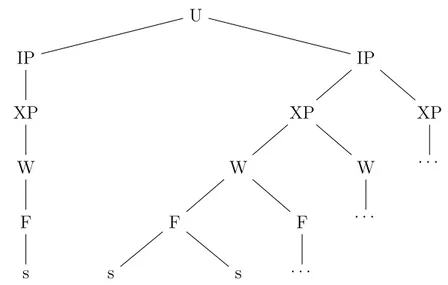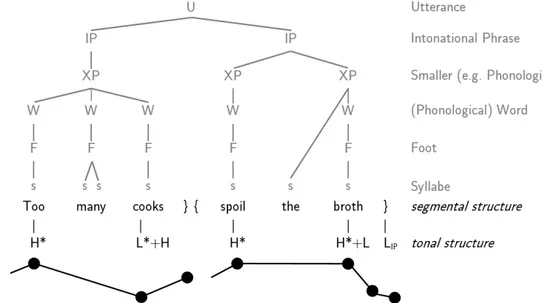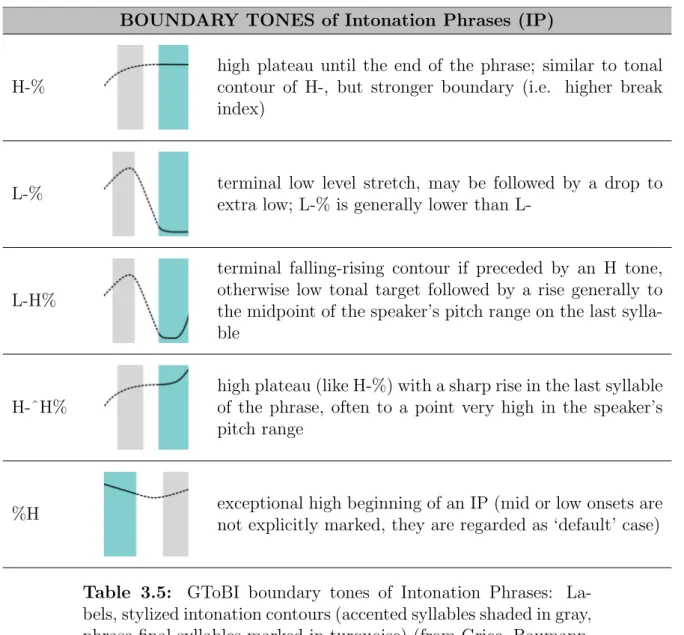Nominal and Verbal Expressions:
Intonational Evidence from Production and Perception
in German
Inaugural-Dissertation zur Erlangung des Doktorgrades
der Philosophischen Fakult¨ at der Universit¨ at zu K¨ oln
im Fach Phonetik
vorgelegt von
Christine Tanja R¨ ohr
aus Duisburg (NRW), Deutschland
K¨ oln, Oktober 2016
Zweite Referentin: Prof. Dr. Martine Grice
Datum der letzten Pr¨ ufung: 11. Januar 2017
The overall goal of this thesis is to shed light on the relation between information structure and prosody, in particular with respect to the dimension of given versus new information (givenness or information status).
According to the activation cost model proposed by Chafe (1994) and Lambrecht (1994) givenness is defined as the degree of activation of an idea or concept assumed by the speaker to be in the listener’s consciousness at the time of utterance. The concept of activation is actually understood to be potentially continuous. The general aim of this thesis is to find further evidence for the basic assumption that (stepwise) changes in the degree of an entity’s givenness are linguistically reflected in corresponding (stepwise) changes in its degree of prosodic prominence (pronounced activation cost).
Evidence for this correlation was obtained by means of production and perception data on read German. Variation in activation or givenness are assumed to be reflected in respec- tive variations in the probability and appropriateness of particular prosodic realizations.
This thesis presents two perception experiments on referential givenness and a produc- tion experiment plus a follow-up perception experiment on semantic relations between verbs and nouns. In contrast to other experimental approaches on the prosodic marking of givenness, the experimental results of this thesis additionally reveal insights into the coding of givenness by prosodic means alone and the informativeness of verbs.
The perception experiments on referential givenness aim to investigate to what extent a range of well-established types of German accents have an effect on the listener’s per- ception of a referent’s level of givenness, both in sentences in isolation and in context.
The main findings are that these different accent types, different accent positions (nu-
clear, prenuclear) and the presence or absence of accent, significantly influence a referent’s
perceived degree of givenness. In particular, results reveal a stepwise decrease in the de-
gree of perceived givenness from deaccentuation and prenuclear accents through low and
early peak (falling) nuclear accents to high and rising nuclear accents. Accordingly, the
absence of an accent and different accent positions differ in their appropriateness as a
The production and perception experiments on semantic relations between different parts of speech were used to investigate the encoding and decoding of the informativeness of verbs in German. Pairs of target verbs and nouns were either semantically unrelated (i.e. new) or related to each other in different ways. In a production study eliciting read speech, these differences in semantic relatedness were found to be expressed in the prosodic realization of the target words, with nuclear accents being more frequent on less related targets. This preference was reflected in appropriateness ratings in a follow-up perception study that investigated nuclear accent placement.
The experimental results of this thesis reveal, in particular, differences in the pronounced probability and perceived appropriateness of nuclear accent placement (and deaccentua- tion) as a function of an entity’s information status.
These differences provide evidence for the relevance of different intermediate levels of cognitive activation between the active and inactive poles, indicating that the notion of information status involves gradient variations rather than categorical distinctions.
Furthermore, the informativeness of verbs has been found to affect the prosodic form of
an utterance just like nouns/referents. Hence, results suggest that verbs serve not only
as a source for a noun’s level of givenness but can also be assigned an information status
themselves. Verbal expressions are not per se referential, but the ideas they express may
be activated to a greater or lesser extent at a lexical level, which indicates the need to
distinguish between a referential and a lexical level of information status.
List of Tables vii
List of Figures ix
1 Introduction 1
I BACKGROUND 7
2 Information Status 9
2.1 Historical Review . . . . 9
2.2 Basic Concepts of Information Structure . . . . 21
2.3 Givenness . . . . 27
2.3.1 Levels and Modes of Givenness . . . . 27
2.3.2 Domains of Givenness in Discourse . . . . 38
2.3.3 Taxonomies . . . . 51
2.3.4 Linguistic Form . . . . 64
3 Intonation 69 3.1 Basic Features and Functions of Prosody . . . . 69
3.2 Phonetic and Phonological Properties of Intonation . . . . 73
3.3 An Autosegmental-Metrical Model of (German) Intonation . . . . 83
3.4 Information Structure and Intonation . . . . 90
II Information Status of NOUNS 99 4 Perception of Referential Givenness 101 4.1 Introduction . . . . 101
4.2 Test Material . . . . 103
4.3 Method . . . . 108
4.4 Signal-Based Perception . . . . 109
4.4.1 Hypotheses . . . . 109
4.4.2 Task . . . . 109
4.4.3 Subjects . . . . 110
4.4.4 Results . . . . 110
4.4.5 Discussion . . . . 111
4.5 Context-Based Perception . . . . 113
4.5.1 Hypotheses . . . . 113
4.5.2 Task . . . . 113
4.5.3 Subjects . . . . 114
4.5.4 Results . . . . 114
4.5.5 Discussion . . . . 117
4.6 Summary and Conclusion . . . . 118
III Semantic Relations between NOUNS and VERBS 121 Introduction 123 5 Production of Relations between Nouns and Verbs 125 5.1 Reading Material . . . . 125
5.2 Hypotheses . . . . 129
5.3 Method . . . . 130
5.3.1 Recordings . . . . 130
5.3.2 Subjects . . . . 130
5.3.3 Analysis . . . . 130
5.4 Results . . . . 132
5.4.1 Verb-NOUN Relations . . . . 132
5.4.2 Noun-VERB Relations . . . . 136
5.5 Discussion . . . . 141
6 Perception of Relations between Nouns and Verbs 145 6.1 Stimuli . . . . 145
6.2 Hypotheses . . . . 146
6.3 Method . . . . 147
6.3.1 Task . . . . 147
6.3.2 Subjects . . . . 148
6.3.3 Analysis . . . . 148
6.4 Results . . . . 149
6.4.1 Verb-NOUN Relations . . . . 149
6.4.2 Noun-VERB Relations . . . . 153
6.5 Discussion . . . . 157
Summary and Conclusion 161 IV Final SUMMARY and CONCLUSION 163 7 The Information Status of Nouns and Verbs 165 Bibliography 170 Appendix A Additional Material: Part II 187 A.1 Test Material . . . . 187
A.2 Selection of Test Stimuli . . . . 193
Appendix B Additional Material: Part III 195 B.1 Test Material: Verb-NOUN Relations . . . . 195
B.2 Test Material: Noun-VERB Relations . . . . 198
B.3 Speakers and Selection of Test Stimuli . . . . 201
B.4 Results: Production . . . . 202
2.1 Terminologies used in the literature that refer to the aboutness dimension of information structure. . . . 24 2.2 Terminologies used in the literature that refer to the focus dimension of
information structure. . . . . 25 2.3 Terminologies used in the literature that refer to the givenness dimension
of information structure. . . . 26 2.4 Overview of Prince’s (1981: 235-237) taxonomy of assumed familiarity. . . . 54 2.5 Overview of terminologies used in annotation schemes for information status
proposed by Nissim et al. (2004) and G¨ otze et al. (2007). . . . 62 2.6 Simplified overview of annotation tags of the RefLex annotation scheme
proposed by Baumann & Riester (2012, 2013). . . . 63 3.1 Articulatory, acoustic and perceptual correlates of suprasegmental features
of speech (adapted from Baumann, 2006: 12). . . . 74 3.2 Prominences at utterance level (adapted from Grice & Baumann, 2007). . . 81 3.3 GToBI pitch accents. . . . 88 3.4 GToBI phrase/boundary tones of intermediate phrases. . . . 89 3.5 GToBI boundary tones of Intonation Phrases. . . . 90 4.1 Sample reading material for the target word Banane with English translation.105 4.2 Examples of seven prosodic realizations on target sentences. . . . 107 4.3 Mean response values on the givenness scale (and standard deviation in
parentheses) for all test sentences with no accent (Ø), a prenuclear accent (PN) and different nuclear accent types (N) on the target referent. . . 111 4.4 Mean response values on the appropriateness scale (and standard deviation
in parentheses) for all test sentences with no accent (Ø), a prenuclear accent
(PN) and different nuclear accent types (N) on the target referent. . . 117
5.1 Target verbs and nouns (with English translation). . . . 125
5.2 (a) verb ← NOUN: Sample mini dialogue with English translation for the result condition of the fotografieren contexts . . . 127 5.3 (b) noun ← VERB: Sample mini dialogue with English translation for the
result condition of the fotografieren contexts. . . 127 5.4 Overview of the different semantic test conditions for the fotografieren con-
texts. . . 128 6.1 (a) verb ← NOUN: Mean response values on the appropriateness scale (and
standard deviation in parentheses) of all target sentences with the nuclear accent on the noun, the verb and the adverb for different sentence types and context types/target items. . . 153 6.2 (b) noun ← VERB: Mean response values on the appropriateness scale (and
standard deviation in parentheses) of all target sentences with the nuclear accent on the noun, the verb and the adverb for different sentence types and context types/target items. . . 157 A.12 Speaker information of production experiment by R¨ ohr & Baumann (2010). 193 A.13 Distribution of speakers and target words in the selection of target sentences
for the perception studies (referential givenness). . . 193 B.8 Speaker information of the production study (semantic relations). . . 201 B.9 Distribution of female speakers in the selection of target sentences for the
perception study (semantic relations). . . 201 B.10 Production data displaying the distribution of nuclear accents on the noun,
the verb and the adverb in the target sentences for female subjects F01-F07.202 B.11 Production data displaying the distribution of nuclear accents on the noun,
the verb and the adverb in the target sentences for female subjects F08-F10 and male subjects M01-M04. . . 203 B.12 (a) verb ← NOUN: Production data displaying the distribution of no ac-
cents, (falling and rising) prenuclear accents and (falling and rising) nuclear accents on the noun, the verb and the adverb in the target sentences. . . . 204 B.13 (b) noun ← VERB: Production data displaying the distribution of no ac-
cents, (falling and rising) prenuclear accents and (falling and rising) nuclear
accents on the noun, the verb and the adverb in the target sentences. . . . 204
2.1 Domains of information. . . . 46 2.2 Summary of various terms of identifiability and activation categories used
in the systems of Lambrecht (1994), Chafe (1974, 1976, 1987) and Prince (1981) (adapted from Lambrecht, 1994: 109). . . . 57 2.3 Activation states, activation costs and time (adapted from Chafe, 1994: 73). 58 3.1 The Prosodic Hierarchy (adapted from Grice, 2006: 779; see also Keating,
Cho, Fougeron & Hsu, 2003). . . . . 75 3.2 Stylized intonation contour for the sentence Too many cooks spoil the broth
and an analysis according to the AM model adapted from Gussenhoven (2002b: 271). . . . 85 4.1 Sample of experimental design and rating task/scale used in the signal-
based perception experiment. . . . 110 4.2 Distribution of no accents (Ø), prenuclear accents (PN) and nuclear accent
types on the givenness scale according to their mean response values. . . . 111 4.3 Sample of experimental design and rating task/scale used in the context-
based perception experiment with a bridging context for the target word Banane. . . 114 4.4 Distribution of no accents (Ø), prenuclear accents (PN) and nuclear accents
(all accent types pooled) on the appropriateness scale according to their mean response values in the four sub-experiments. . . 115 4.5 Distribution of no accents, prenuclear accents (PN) and nuclear accents
types on the appropriateness scale according to their mean response values in the four sub-experiments. . . 116 5.1 Praat annotation sample of the sentence ‘I’ve heard they like to sell the pic-
tures.’ from speaker F03 with oscillogram (top panel), F0 contour (middle
panel) and three annotation tiers (bottom panel). . . 131
5.2 (a) verb ← NOUN: Relative distribution of nuclear accents on the noun, the verb and the adverb in all target sentences. . . . 132 5.3 (a) verb ← NOUN: Relative distribution of nuclear accents on the verb, the
adverb and the noun in object-final target sentences (S-V-Adv-O). . . 133 5.4 (a) verb ← NOUN: Relative distribution of nuclear accents on the adverb,
the noun and the verb in verb-final target sentences (S-Adv-O-V). . . 134 5.5 (a) verb ← NOUN: Relative distribution of nuclear accents on the noun, the
verb and the adverb in the target sentences of different context types/target items. . . . 134 5.6 (a) verb ← NOUN: Relative distribution of no accents, prenuclear accents
and falling and rising nuclear accents on the target noun in the two sentence types. . . . 136 5.7 (b) noun ← VERB: Relative distribution of nuclear accents on the noun,
the verb and the adverb in all target sentences. . . . 137 5.8 (b) noun ← VERB: Relative distribution of nuclear accents on the verb,
the adverb and the noun in object-final target sentences (S-V-Adv-O). . . . 138 5.9 (b) noun ← VERB: Relative distribution of nuclear accents on the adverb,
the noun and the verb in verb-final target sentences (S-Adv-O-V). . . 138 5.10 (b) noun ← VERB: Relative distribution of nuclear accents on the noun, the
verb and the adverb in the target sentences of different context types/target items. . . . 139 5.11 (b) noun ← VERB: Relative distribution of no accents, prenuclear accents
and falling and rising nuclear accents on the target verb in the two sentence types. . . . 141 6.1 Sample of experimental design and rating task/scale used in the follow-
up perception experiment (verb ← NOUN relation) displaying the result(- stem) condition of the fotografieren contexts. . . 147 6.2 (a) verb ← NOUN: Mean appropriateness ratings of all target sentences
with the nuclear accent on the noun, the verb and the adverb. . . 149 6.3 (a) verb ← NOUN: Mean appropriateness ratings of target sentences with
the nuclear accent on the noun, the verb and the adverb for the two sentence types. . . . 152 6.4 (a) verb ← NOUN: Mean appropriateness ratings of target sentences with
the nuclear accent on the noun, the verb and the adverb for different context types/target items. . . 152 6.5 (b) noun ← VERB: Mean appropriateness ratings of all target sentences
with the nuclear accent on the noun, the verb and the adverb. . . 154
6.6 (b) noun ← VERB: Mean appropriateness ratings of target sentences with the nuclear accent on the noun, the verb and the adverb for the two sentence types. . . . 155 6.7 (b) noun ← VERB: Mean appropriateness ratings of target sentences with
the nuclear accent on the noun, the verb and the adverb for different context
types/target items. . . 156
Introduction
In a communicative situation the ‘informative’ part of a message is usually expressed and interpreted in relation to information that is already ‘known’ by the interlocutors. Accord- ingly, the dimension of given versus new information is a central part in the investigation of information structure. This thesis is particularly concerned with the investigation of the relation between givenness (also called information status) and prosody.
In intonation languages like German, the marking of information status is an important linguistic function of prosody. Nevertheless, in the literature the various approaches to givenness differ with respect to the level this notion applies to. An adequate analysis of givenness clearly requires consideration of the positions of both speaker and listener. Our notion of information status/givenness is based on a (cognitive) activation cost approach as proposed by Chafe (1994) and Lambrecht (1994). They define givenness as the degree of activation of a concept or idea that the speaker assumes to be in the listener’s con- sciousness at the time of utterance. This means, a referent that is stored in the listener’s long-term memory is considered activated, or given, only if it is activated in the listener’s consciousness by the discourse context. Chafe and Lambrecht postulate three steps on a potentially continuous scale of cognitive activation that correspond to three different types of information status: In addition to given (active) and new (inactive) information they propose an intermediate level of cognitive activation that can be referred to as ac- cessible (semi-active) information. This concept of givenness also implies ‘activation cost’
(e.g. expressed by prosodic means), relating to the effort a speaker has to make in order to transfer an idea from a previous (less active) state into an active state: the lower the activation of an item, the higher its activation costs.
With regard to the information structural component of language, a crucial distinction is
often made between information about states and events on the one hand, and information
since they are constantly replaced by other states and events. Referents, by contrast, remain active for a longer period and serve as anchor points for new information over a larger stretch of discourse (cf. Chafe, 1994).
Recent annotation schemes are able to capture fine-grained differences in an item’s infor- mation status (e.g. different types of accessible information). They tend to concentrate on the information status of noun phrases (NPs), denoting referential or lexical relations between the same parts of speech, i.e. two referring expressions (usually argument cate- gories like NPs/DPs, PPs and pronouns). Different parts of speech, e.g. verbs and nouns, can also be semantically interrelated. Accordingly, some systems also include verbs and verb phrases (VPs) as a possible source of a referent’s accessibility. However, due to their non-referential character, verbs are usually not assigned an information status themselves.
In terms of prosody, several studies on West Germanic languages have shown that the commonly assumed dichotomy of new vs. given information and their marking as accented vs. unaccented is inappropriate for a general account of information status. In fact, recent studies indicate that differences in reference relations between NPs (reflecting differences in cognitive activation or givenness) are expressed by the choice of nuclear pitch accent placement and/or pitch accent type. More precisely, the studies provide evidence that accessible information cannot be treated as a uniform category and that different types of more or less activated information demand different accent types as linguistic markers:
The less activated or given the referent, the higher the prosodic prominence produced.
The role of verbs in the prosodic marking of information status has not been investigated so far.
The current evidence suggests that there is still need for further insight into the (de-)coding of givenness by prosodic means. Hence, the present thesis is concerned with the following research questions:
(1) How can linguistically/prosodically relevant differences in an entity’s cognitive acti- vation be adequately measured?
(2) To what extent are different intermediate levels of cognitive activation between the active and inactive poles linguistically relevant? (indicator of categorical distinctions vs. gradient variations of givenness)
(3) How informative are verbs and how relevant is their (potential) information status
for the prosodic form of an utterance?
(4) Which role does prosody or do different prosodic features play in the production and perception of givenness?
This thesis set out to explore these research questions, by carrying out carefully controlled production and perception experiments on read German.
Two related perception experiments (see also R¨ ohr & Baumann, 2010; R¨ ohr, 2013; Bau- mann, R¨ ohr & Grice, 2015) are used to examine whether different accent types and po- sitions have an effect on the listener’s perception of a referent’s/noun’s level of givenness (see part II). The first experiment investigates the perceived degree of a target referent’s givenness solely by its prosodic marking. Seven different prosodic realizations are evalu- ated. The second experiment tests the appropriateness of the seven prosodic realizations with regard to the target referent’s information status within a context. A distinction is made between given, textually accessible, inferentially accessible and new referents.
A production experiment and a follow-up perception experiment (see also R¨ ohr, Baumann
& Grice, 2015) are employed to examine the effect of different semantic relations between verbs and nouns within the same discourse on their prosodic realization (see part III).
Two types of reference relations are investigated - (a) nouns that can be linked back to a preceding verb and (b) verbs that can be linked back to a preceding noun. For both refer- ence types, five types of information status are distinguished by using different verb-noun pairs. We assume that the level of activation or givenness of a target verb/noun differs in relation to its semantic relation to a preceding element. In turn, we expect this differ- ence to be reflected in the prosodic marking of the target element, in particular in terms of nuclear accent placement. By the same token, we assume that the listener is able to interpret an element’s information status by means of its degree of prosodic prominence.
Insights may contribute to a more elaborate account of information status and the im-
provement of annotation schemes of information status and computational based annota-
tion tools that involve automatic annotation processes. Furthermore, insights about the
(de-)coding of givenness by prosodic means (alone) contribute to the comprehension of the
general interplay between lexicogrammatical aspects and prosody in information structur-
ing and thus help to define the role prosody plays in the extensive field of information
structure. Furthermore, such findings will help to specify the relation between intonational
form and function, whereby systems for manual and automatic prosodic transcription and
also systems for speech synthesis and speech recognition can be improved.
This thesis is structured into four parts. Part I provides the theoretical background for the subsequent parts II and III which constitute the experimental parts of this thesis. Part IV contains a general summary of the experimental results and a final conclusion.
Part I (chapters 2 and 3) provides a theoretical background on the most relevant aspects on information status and intonation and their interrelation.
Chapter 2 is devoted to the notion of information status. The first section 2.1 aims to locate the notion of information status within the more general notion of information structure. This is done on the basis of a historical review of the different notions that are related to information structure in the literature. The following section 2.2 discusses and defines the basic contemporary concepts of information structure, including the concept of givenness. The last section 2.3 in chapter 2 provides a closer look into various aspects of the givenness dimension (information status). The presentation involves a discussion of the criteria used to identify units of givenness from different levels and perspectives (sec- tion 2.3.1), of the domains of application (section 2.3.2), of different taxonomies (section 2.3.3) and of general aspects of the linguistic form of information status (section 2.3.4).
Chapter 3 deals with the role of intonation in intonation languages, starting with an intro- duction of the basic features and functions of prosody in section 3.1. The following section 3.2 discusses the phonetic and phonological properties of intonation with regard to the two main functions of highlighting and phrasing. Section 3.3 introduces the most relevant phonological models of intonation and provides a description of the autosegmental-metrical annotation system (G)ToBI that is used for the intonation analysis in the experimental data of this thesis. Finally, in section 3.4 the findings of different studies that reveal empirical evidence for the relation of information status and prosody are discussed.
Part II (chapter 4) presents two perception experiments that are concerned with the ref- erential level of givenness and its decoding by intonational means. The first experiment (section 4.4) tests the perceived givenness of target referents presented with different prosodic realizations in sentences in isolation. The second experiment (section 4.5) tests the perceived appropriateness of the same sentences in (relation to the referent’s informa- tion status in) context.
Part III (chapters 5 and 6) presents a production and a follow-up perception experiment
that in particular aim to explore the informativeness of verbs in German. The experiments
investigate the intonational encoding and decoding of different semantic relations between
verbs and nouns. After a general introduction the production experiment is presented in
chapter 5 and the follow-up perception experiment in chapter 6. The findings of both
experiments are subsequently summarized and discussed.
Finally, part IV (chapter 7) comprises a summary of all experimental results as well as
a general discussion and conclusion with regard to the research questions presented in
chapter 1.
BACKGROUND
Information Status
2.1 Historical Review
This section aims to provide the historical background for the contemporary understanding of the notion of information structure (see following section 2.2) and the role of givenness by presenting a selection of the most relevant approaches of the last two centuries.
First theories on word order and sentence structures that not only take syntactic but also other linguistic aspects into account already capture the most relevant features of information structure (e.g. Weil, 1844/1978; von der Gabelentz, 1869; Paul, 1880/1920;
Ammann, 1928/1962, Prague School: Mathesius, Firbas, Daneˇs, etc.): Often based on psychological and/or communicative factors, they postulate in addition to the grammatical sentence organization a thematic organization of a sentence into (at least) two information- bearing parts.
Early Psychological Approaches
Weil (1844/1978: 29) introduces the above mentioned idea as follows:
There is then a point of departure, an initial notion which is equally present
to him who speaks and to him who hears, which forms, as it were, the ground
upon which the two intelligences meet; and another part of discourse which
forms the statement (l’nonciation), properly so called. This division is found
in almost all we say.
The basic assumption of Weil and also von der Gabelentz and Paul is that a sentence reflects the structure of the speaker’s thoughts and ideas and is used to evoke those thoughts and ideas in the listener’s mind.
However, in contrast to Weil’s definition, von der Gabelentz’s (1869) definition of the thematic two-part structure of a sentence is rather psychologically motivated, namely by the nature of the thought the speaker wants to convey. He assumes that it is composed of a ‘psychological subject’ and a ‘psychological predicate’. With the former term he refers to the entity to which the speaker initially wants to draw the listener’s attention to. With the latter term he refers to what the listener shall think about this entity (cf.
1869: 378). These psychological categories are solely determined by their position in the sentence (psychological subject in first, and psychological predicate in second position) and are clearly kept apart from the grammatical subject and predicate categories.
Paul (1880/1920) adopts the terminology introduced by von der Gabelentz but has a different explanation. The psychological predicate is interpreted as the most important and relevant part of a message. The psychological subject is interpreted as the part of a message that is already known by the interlocutors and serves as a starting point for new information. In addition, the two parts are defined not only by word order but also by intonation: Paul notes that the psychological predicate is the constituent that carries the strongest tone of the sentence (cf. 1880/1920: 283). Furthermore, he claims that the relation between the grammatical categories is based on the relation between the psychological ones, even though psychological and grammatical subject or predicate do not always coincide.
Communicative Functional Approaches/Prague School
Ammann (1928/1962) mostly supports von der Gabelentz’s idea of the binary division of a sentence into subject and predicate. However, he does not argue from a psychologi- cal perspective but rather attributes the binary character of a sentence primarily to the communicative function of the sentence as a message. Using a different pair of terms -
‘theme’ and ‘rheme’ - he distinguishes between the general subject of a message (‘Gegen- stand’, subject/theme) and the content of a message (‘Inhalt’, predicate/rheme) or the new/newsworthy information about the subject.
The Czech linguist and cofounder of the Prague School or Prague linguistic circle, Math-
esius (1929/1983, 1939/1975), criticizes the early psychological approaches and, in order
to explain sentence form, suggests proceeding from the speaker’s standpoint and the com-
municative task of a sentence in a given situation.
1This ‘functional sentence perspective (FSP)’ is the basis for his work on word order phenomena in Czech. Therein he clearly differentiates the thematic organization, or in his terms ‘topical articulation’, of a sen- tence from its grammatical organization or ‘formal articulation’ respectively. He also uses the terms theme and rheme in his representation of the thematic/topical sentence organization. However, unlike Ammann, his definition focuses on a distinction between
‘known’ (familiar) and ‘unknown’ (new) information that is reminiscent of the distinctions formulated by Weil (1844/1978) or Paul (1880/1920).
The intrinsic word-order factor in Czech is the aspect of functional sentence perspective. Every bipartite utterance is composed of two components, the first of which expresses something relatively new and contains what is asserted by the sentence. It is that part of the sentence which is sometimes called the psychological predicate and which, for the sake of a clearer distinction from the grammatical predicative with which it does not always coincide, I prefer to call the rheme of the utterance. The second part of the sentence contains the basis of the utterance or theme, the psychological subject according to earlier terminology, i.e. things relatively familiar or most readily available to the speaker as the starting point. (Mathesius, 1929/1983: 126-127)
Mathesius (1941) later prefers to distinguish between ‘basis’ (theme) and ‘nucleus/core’
(rheme) rather than known and unknown information and diverges from the idea of a mere sentence dichotomy (see also Sgall, Hajiˇ cov´ a & Beneˇsov´ a, 1973 and Daneˇs, 1974). The basis defines the part that is spoken about in the sentence and the nucleus defines what is said about this part. The basis containing more than one element may be composed of a
‘most topical’ element (the center of the theme) and ‘accompanying elements’ leading to the nucleus. Mathesius furthermore adds the idea of elements that represent a transition (e.g. the predicate) between basis and nucleus.
2Firbas (1964, 1966) develops these ideas of FSP further. By additionally taking the viewpoint of the hearer (the receiver of information) into account he argues for the need of a more elaborate definition of the distinction between known and unknown/new information.
As a consequence, he introduces a different and non-categorical criterion that is assumed to affect sentence structure - ‘the degree of communicative dynamism (=CD)’:
By the degree of CD carried by a sentence element we understand the extent
1“What makes a sentence a sentence is the active attitude of the speaker to its content.” (Mathesius, 1929/1983: 124)
2A similar idea has already been mentioned by Paul (1880/1920: 284). He notes that besides the psychological predicate one particular element can stand out as psychological subject, while the remaining sentence elements serve as link between subject and predicate.
to which the sentence element contributes to the development of the commu- nication, to which it ‘pushes the communication forward’, as it were. (Firbas, 1964: 270)
The general assumption is that, in accordance with the surface word order, the degree of CD gradually increases over the sentence elements, from the beginning towards the end of a sentence. Known elements are believed to have lower degrees of CD and therefore constitute elements of the theme, while unknown/new elements are believed to have higher degrees of CD and constitute elements of the rheme. Hence, in FSP the ‘basic distribution’
of CD is a theme-transition-rheme sequence. However, Firbas brings two further factors into play that have an effect on the ‘thematizing’ of sentence elements: semantic structure and context dependence. This means that the ‘final distribution’ of CD is determined by an interplay of linear word order, the semantic content and relation of the sentence elements and their (in)dependence of the relevant verbal/textual or situational context.
In his ‘theory of utterance’ or ‘utterance organization’ Daneˇs (1964, 1970, 1974) picks up on Mathesius’s and Firbas’s ideas but criticizes their use of the notions ‘theme’ and ‘known (given) information’. Firbas’s degrees of CD show that both notions are closely related or even mutually dependent. This is also reflected in Mathesius’s (1929/1983, 1941) definition of the ‘starting point’ of an utterance, since the relating terms, basis/theme/familiar information, are used either to refer to the piece of information that is spoken about and/or to the known/given piece of information in a sentence. Daneˇs (1974) points out that such an undifferentiated definition is problematic, since there is evidence that the theme of an utterance (in the former sense) does not necessarily convey known information.
Therefore, he proposes an utterance organization within FSP along two lines: He argues that “ theme (something that one is talking about, topic ) and rheme (what one says about it, comment )” (1970: 134; see also Daneˇs, 1964) may be defined from a sentence- internal point of view, while old/known/given and new elements (functioning as ‘starting point’ and ‘core’ of the utterance, respectively) may be defined by their relation to the context and/or situation.
3The early psychological and communicative theories discussed so far have been shown to define sentence constituents on a non-grammatical, information-bearing level either by sentence-internal (cf. von der Gabelentz, 1869 and Ammann, 1928/1962) or by contextual aspects (cf. Weil, 1844/1978 and Paul, 1880/1920) or by a combination of both (cf. Prague
3Even though these two aspects need to be evaluated along different lines, Daneˇs (e.g. 1970) proposes a theory of ‘thematic progression’, which organizes the theme within a sentence with regard to the plot of a whole text and the situation. This approach is based on the assumption that each theme is derived from the subject matter already presented in the given discourse or from the common knowledge stock of the discourse participants, i.e. the theme is commonly related to givenness.
School). In the following we will differentiate between the level of ‘aboutness’ and the level of ‘informativeness’ in order to refer to sentence-internal and contextual concepts, respectively. This difference in the nature of information-bearing sentence components as described by Daneˇs has also been pointed out by other linguists (e.g. Halliday, 1967b
4) and turned out be a fundamental distinction in theories on information structure.
A Systemic Functional Approach
The term ’information structure’ was used for the first time by the American structuralist (systemic functional) Halliday (1967b). In the general sense it serves as a cover term for phenomena concerning “the distribution of information in the clause as a message”
(1967b: 200) that are the object of one main syntactic area, namely the grammar of dis- course (called ‘theme’).
Theme is concerned with the information structure of the clause; with the status of the elements not as participants in extralinguistic processes but as components of a message; with the relation of what is being said to what has gone before in the discourse, and its internal organization into an act of communication [. . . ]. (Halliday, 1967b: 199)
Halliday describes six different, but related sets of options with particular structural func- tions or roles that determine the general information structure of a clause: While the options ‘information’ (informativeness level), ‘thematization’ (aboutness level) and ‘iden- tification’ concern the clause as a whole, the options ‘predication’, ‘substitution’ and
‘reference’ concern the status of single clause elements.
However, in the narrower sense Halliday also uses the term information structure to refer to a particular distribution of the discourse which is determined only by the informa- tion options: That is the organization of a text into a (linear) sequence of meaningful
‘information units’ or message blocks. The components within an information unit are further organized into ‘information focus’ and ‘new’ and ‘given’ elements in relation to the preceding discourse. “Information focus reflects the speaker’s decision as to where the main burden of the message lies” (1967b: 204) and is to be interpreted as the informative (‘new’) part of a message. This notion is reminiscent of Paul’s (1880/1920) interpretation of the psychological predicate (and also Firbas’s degrees of CD) and brings yet another aspect into play, namely the level of an element’s communicative importance (‘emphasis’).
4“The difference can perhaps be best summarized by the observation that, while ‘given’ means ‘what you were talking about’ (or ‘what I was talking about before’), ‘theme’ means ‘what I am talking about’
(or ‘what I am talking about now’) [. . . ]” (Halliday, 1967b: 212)
The domain of information focus is said to have the function ‘new’ and the optional re- maining domain is said to have the function ‘given’ within an information unit. However, new (focal) information is not understood in the sense that it cannot have been previ- ously mentioned, but in the sense that it is what the speaker chooses to present as new or interprets as non-derivable information.
5This means, that the focus of an utterance can present either information that is not derivable from the preceding discourse, or in- formation that is familiar or has been previously mentioned. In the latter case the focus constituent usually provides a contrastive or alternative statement to a previous predic- tion. Thus, even though focus is closely related to ‘new information’, the definition of focus differs from a given-new distinction which is genuinely determined by the textual or situational environment. Therefore these two concepts, while both related to the level of informativeness, are defined along different lines and should be located on two different dimensions, which we will refer to as the ’focus’ and ’givenness’ dimensions.
Halliday’s information structure involves yet another innovation. He argues that in con- trast to the other sets of options, information options do not operate on the syntactic constituent structure but on a suprasegmental level. That is, “one information unit is realized as one tone group” (1967b: 200). Its internal structure is reflected by at least one obligatory ‘tonic segment’, which expresses the point of information focus, and one optional ‘pretonic segment’. Herewith Halliday introduces a new concept of information(- bearing) structure that operates independently of the syntax-semantics interface.
A Generative Approach
In the realm of (transformational-)generative grammar and more semantically-based gram- mar Chomsky (1972) also discusses the alternative determination of ‘semantic represen- tations’ (or ‘readings’) of a sentence in terms of phonetic representations (e.g. the intona- tional contour). He notes that not only the expressed proposition but also aspects of its form are relevant to the meaning or ‘realization’ of a sentence. Examining the relation of syntactic structure to semantic representation, he argues for the development of a system that is able to represent how the meaning of a sentence is related to various aspects of its form. Thereby his main concern is to define the role of ‘surface structures’ (mapped into phonetic representations) and post-lexical or ‘deep structures’ (basic syntactic structure after insertion of all lexical items into a phrase-marker; mapped into semantic repre- sentations). The basic assumption is that semantic structures are determined by deep structures. However, there are cases in which there seems to be a more direct relation to
5See Schwarzschild (1999) and von Heusinger (1999) for a discussion of different readings of new information in Halliday’s approach.
surface structure. This is demonstrated in particular for the representation of the ‘focus (F)’ and the ‘presupposition (P)’ of a sentence. Each sentence is supposed to contain a class of pairs of F P, whereby in a natural response the focus is said to be the only element that differs from the preceding utterance, while the presupposition (sentence minus focus element) has already been mentioned before.
6Chomsky points out that the focus can alternatively be determined by the surface structure: “The focus is a phrase containing the intonation center; the presupposition, an expression derived by replacing the focus by a variable.” (1972: 100) This notion of focus and presupposition is closely related to Halliday’s (1967b) notion of information focus, whereas in Chomsky’s account the inter- pretation of focus depends primarily on semantic rather than on prosodic aspects (for a semantic theory of focus see Jackendoff (1972) and H¨ ohle (1982)).
Cognitive Approaches
Colleagues of the newer Prague School (e.g. Sgall, Hajiˇ cov´ a & Beneˇsov´ a, 1973) try to integrate the theories of FSP into a generative framework (‘functional generative descrip- tion’)
7. They propose a theory of ‘topic-focus articulation (TFA)’ (or ‘topic-comment articulation (TCA)’) that is based on Firbas’s (1964) approach and proceeds from the basic linguistic distinction between the ‘topic’ of a sentence and its ‘focus’. Similar to Chomsky they believe that all sentences have a focus domain that is determined by the relation of the response to the preceding utterance/question, i.e. it corresponds to the wh- expression in a presupposed question
8(see also B¨ uring’s, 1997, 2007 notion of ‘question- answer-congruence’). Focus is assumed to signal what is presented as new or important information and identifies what is said about the topic. However, Sgall, Hajiˇ cov´ a &
Beneˇsov´ a argue that there is an important difference between formal (e.g. word order and prosody) and functional aspects (e.g. semantics and context). Furthermore, they criticize Firbas’s vague explanation of how to determine the degrees of CD over the sentence ele- ments and give a refined definition of his semantic and contextual factors by introducing the concepts of ‘communicative importance’ and ‘contextual boundness’. While commu-
6“Choice of focus determines the relation of the utterance to responses, to utterances to which it is a possible response, and to other sentences in the discourse. The notions “focus”, “presupposition”, and
“shared presupposition” [. . . ] must be determinable from the semantic interpretation of sentences [. . . ].”
(Chomsky, 1972: 100)
7Their grammar consists of a generative component which generates semantic representations or underlying structures for sentences.
8“In simple cases we can say immediately on the basis of a possible question [. . . ] which part of the sentence is the topic and which is the comment: the elements that are necessarily present in the question belong to the topic; those that cannot be in the question belong to the comment; the elements that may, but need not necessarily be present in the question belong, according to some views, to the so-called transition.” (Sgall, Hajiˇcov´a & Beneˇsov´a, 1973: 29)
nicative importance is a hierarchy derived from the semantic role of individual sentence participants, contextual boundness is defined in terms of a cognitive concept.
A contextually-bound element is interpreted as the point of information that is stored in the hearer’s memory, which generally means that it is known to the hearer from the context or situation of the discourse. However, it is additionally noted that only some elements of the speaker’s memory are ‘foregrounded’ by the discourse. Therefore a contextually- bound element is more precisely interpreted in the sense of what the speaker assumes to be present in or immediately available to the listener’s consciousness in the discourse.
The following statement demonstrates to what extent the speaker’s assumptions about an element’s contextual boundness are relevant for communication:
An old maxim says that TCA consists, first of all, in the distinction between
’what is spoken about’ and ’what is said about it’ in a sentence. [. . . ] It is more exact to say that it belongs to a basic property of communication that one of its participants, the speaker, attempts to make the other(s), the hearer(s), modify in some respects some points of the information stored in the hearer’s memory. (Sgall, Hajiˇ cov´ a & Beneˇsov´ a, 1973: 10).
The cognitive aspect of information structure and its relevance for communication as formulated in the theory of TFA/TCA has been further developed by other linguists and turned out to be a central aspect in later notions of information structure (e.g. by Chafe, 1976; Prince, 1981; Vallduv´ı, 1992; Lambrecht, 1994).
Along these lines Chafe (1976) describes how the content of what is being said is trans- mitted under the term (information) ‘packaging’. He singles out six main packaging phe- nomena that denote the various syntactic and cognitive statuses a noun or a referent
9in a sentence may have: ‘givenness’ (givenness dimension resembling the concept of contextual boundness), ‘contrastiveness’ (particular aspect of focus dimension), ‘definiteness’, ‘sub- ject’ (aboutness dimension), ‘topic’ and ‘point of view’.
The cognitive aspect of this approach results from the basic idea that the speaker ‘packs’
information in such a way that it can be readily processed by the addressee at the moment of utterance. Hence, the addressee’s processing abilities play an important role. Chafe assumes that in a communicative situation a person is only thinking, or is conscious of, a certain part of his or her long-term knowledge with regard to (the background of) the discourse context. These so-called “temporary states of the addressee’s mind” (1976: 280) define the addressee’s processing abilities and have to be taken into account by the speaker when he is talking to a person. This means, a noun’s packaging statuses are identified with regard to what the speaker assumes to be in the listener’s mind/consciousness at
9“[. . . ] a referent is the idea a noun is used to express.” (Chafe, 1976: 28)
the time of utterance. However, similar to Sgall, Hajiˇ cov´ a & Beneˇsov´ a’s (1973)approach this criterion seems to be primarily relevant to the definition of an element’s status of givenness. Relating to this, Chafe notes that the terms ‘given’ and ‘new’ are misleading and argues that it would be more accurate to distinguish between ‘already activated’ and
‘newly activated’ information (see section 2.3.3 for further discussion). He furthermore directly connects the given-new distinction to Firbas’s degrees of CD and thereby raises the question as to whether there are intermediate degrees of givenness/activation.
10This question is also addressed by Prince (1981). Following Chafe, she assumes that for information packaging in natural language ”[. . . ] the crucial factor appears to be the tailoring of an utterance by a sender to meet the particular assumed needs of the in- tended receiver” (1981: 224). The structure and distribution of given-new information is the central aspect in her approach of information packaging. She relates notions like predictability/recoverability, saliency and shared knowledge to the given-new distinction.
Assuming that these notions are not mutually independent, her aim is to develop a taxon- omy that combines the different levels/types of givenness. As a consequence, she proposes a taxonomy of ‘Assumed Familiarity’ (applied to individual ‘discourse entities’ of a par- ticular ‘discourse model’) that clearly diverges from a binary given-new distinction but suggests a rather ternary or even scalar taxonomy of the givenness dimension (see section 2.3.3). Prince’s approach is based on the assumption that a linguistic theory of discourse should be able to account for the correlation between a taxonomy of morphological and syntactic form and a taxonomy of the values of assumed familiarity. With this she points out an essential parameter of cognition-based theories on information structure:
We are, therefore, not concerned with what one individual may know or hy- pothesize about another individual’s belief-state except insofar as that knowl- edge and those hypotheses affect the forms and understanding of linguistic productions. (Prince, 1981: 233)
Within the scope of information packaging Vallduv´ı (1992) also argues that a binary
‘informational split’ of a sentence is not enough. However, in contrast to Prince he is not concerned with the givenness dimension. He states that:
[. . . ] referential status is a property of discourse entities and the phrases that encode them and information packaging is a relational property that con- stituents have by virtue of their standing in a particular relationship with the other element of the sentence. (1992: 54)
10Due to the lack of linguistic evidence for the scalarity of the distinction this aspect is not further discussed in Chafe (1976) but continued in his later work, e.g. Chafe (1987, 1994).
Furthermore, he ascribes information packaging to have an autonomous status in the field of semantics and pragmatics and therefore subsumes corresponding notions under the term ‘informatics’. Vallduv´ı proposes a ‘trinomial hierarchical articulation’ with the basic units ‘focus’, ‘link’ and ‘tail’, that represent the informational split of a sentence and incorporate different notions of the aboutness and focus dimension. Information packaging is defined in terms of “[. . . ] A small set of instructions with which the hearer is instructed by the speaker to retrieve the information carried by the sentence and enter it into her/his knowledge-store.” (1992: 15)
11Thus, the information packaging instructions play a central role in the informatics approach. They are represented by a sentence or rather by the arrangement of the basic units of the trinomial hierarchical articulation in a sentence. Vallduv´ı’s idea of a tripartite informational split goes back to Dahl (1974), who distinguishes between a ‘topic-comment’ and a ‘focus-background’ structure, but argues for a parallel organization that may result in a tripartite structure, in particular in the case of longer sentences. Unlike Dahl, Vallduv´ı suggests a hierarchical organization of the two structures with the basic/superordinate distinction attributed to the focus dimension (cf. Vallduv´ı, 1992: 57-61): Focus is understood to be the only obligatory and informative part of a sentence (identified by context) and therefore represents the only contribution to the hearer’s knowledge-store. The focus (or information) part is complemented by the
‘ground’ which is already part of the hearer’s knowledge-store and therefore does not make any contributions to it. However, the ground serves to indicate the appropriate ‘anchoring’
or entry of information in the knowledge-store and is further divided into ‘link’ and ‘tail’.
The link is a topic-like expression that opens the sentence and links up with the object of thought. While the link indicates where (or under which ‘address’) the information of a sentence is entered in the hearer’s knowledge-store, the tail (‘nonfocal nonlink part’) indicates how this information must be entered under the given address.
Vallduv´ı’s approach to ‘digesting’ the sentence-internal relations of the focus and aboutness dimension into a single information structure yet again demonstrates the close or even mutual relatedness between both dimensions. Nevertheless, his approach also shows the need to (still) distinguish between different aspects or dimensions of information structure:
While the focus-ground relation is primarily a context-dependent property (as in Halliday’s (1967b) approach), the link-tail relation is primarily a sentence-internal property.
Lambrecht’s (1994) work on ‘information structure’ also addresses the question of why there are so many kinds of sentence structures and how they are stored in the memory of speakers and hearers. By combining insights from different formal and functional ap- proaches to information structure he aims to elaborate the basic concepts and terms that
11The structure of the hearer’s knowledge-store is metaphorically compared with a file whose file cards are added and updated during a discourse (based on Reinhart, 1981 and Heim, 1983).
